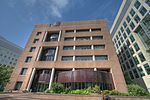Building 20

Building 20 (18 Vassar Street, Cambridge, Massachusetts) was a temporary timber structure hastily erected during World War II on the central campus of the Massachusetts Institute of Technology. Since it was always regarded as "temporary", it never received a formal name throughout its 55-year existence. (Many major buildings at MIT are known by their numbers regardless of how neoclassical or otherwise permanent they may be.) The three-floor structure originally housed the Radiation Laboratory (or "Rad Lab"), where fundamental advances were made in physical electronics, electromagnetic properties of matter, microwave physics, and microwave communication principles, and which has been called one of America's "two prominent shrines of the triumph of science during the war" (along with the desert installation at Los Alamos, where the atomic bomb was born). A former Rad Lab member said, "At one time, more than 20 percent of the physicists in the United States (including nine Nobel Prize winners) had worked in that building".After the Rad Lab shut down after the end of World War II, Building 20 served as a "magical incubator" for many small MIT programs, research, and student activities for a half-century before it was demolished in 1998.
Excerpt from the Wikipedia article Building 20 (License: CC BY-SA 3.0, Authors, Images).Building 20
Vassar Street, Cambridge Cambridgeport
Geographical coordinates (GPS) Address Nearby Places Show on map
Geographical coordinates (GPS)
| Latitude | Longitude |
|---|---|
| N 42.3619 ° | E -71.0905 ° |
Address
Ray & Maria Stata Center (32) (Building 32)
Vassar Street 32
02139 Cambridge, Cambridgeport
Massachusetts, United States
Open on Google Maps








